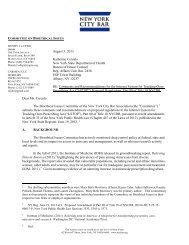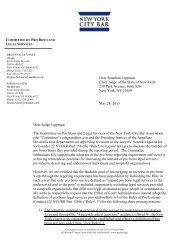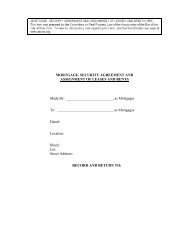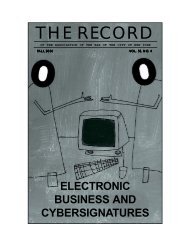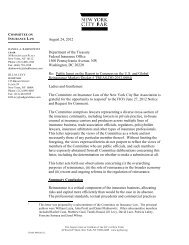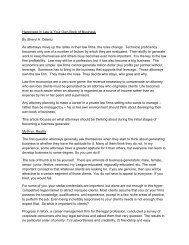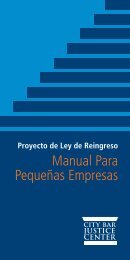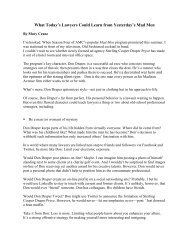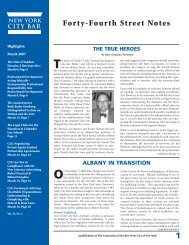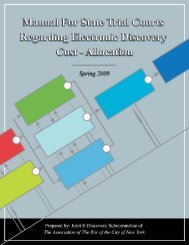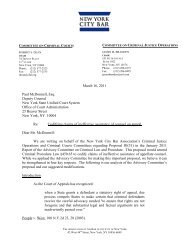2007 Issue 1 - New York City Bar Association
2007 Issue 1 - New York City Bar Association
2007 Issue 1 - New York City Bar Association
Create successful ePaper yourself
Turn your PDF publications into a flip-book with our unique Google optimized e-Paper software.
C I V I L R I G H T S, I N F O R M A T I O N T E C H N O L O G Y L A W,<br />
L E G A L I S S U E S A F F E C T I N G P E O P L E W I T H D I S A B I L I T I E S<br />
requires physical, architectural accessibility to “places of public accommodation.”<br />
14 Such a focus assumes that “place” is defined in the ADA—as<br />
it is not—as a location people can enter bodily to offer or to seek goods<br />
and/or services. It also assumes that Title III’s requirement of access to<br />
“facilities” excludes Website “facilities.” These assumptions do not bear<br />
reasonable scrutiny under the ADA. However, confusion fostered by such<br />
assumptions has led to the legally hazardous inaccessibility of the Websites<br />
of many public accommodations.<br />
The ever more vital role of the World Wide Web in American life makes<br />
it crucial to set forth, as we do here, an appropriate legal analysis that will<br />
secure the Web’s accessibility to millions of people with disabilities.<br />
3. Title III of the Americans with Disabilities Act<br />
Requires Opportunity for “Full and Equal Enjoyment”<br />
of “Public Accommodations”<br />
The operative section of Title III of the ADA, entitled “Prohibition of<br />
discrimination by public accommodations,” states:<br />
No individual shall be discriminated against on the basis of<br />
disability in the full and equal enjoyment of the goods, services,<br />
facilities, privileges, advantages, or accommodations of any<br />
place of public accommodation by any person who owns, leases<br />
(or leases to), or operates a place of public accommodation. 15<br />
The statute also sets forth categories of “public accommodations,”<br />
which include most private entities that offer goods and services to customers.<br />
16 As discussed below, there are two alternative conceptual frame-<br />
14. E.g., 42 U.S.C. § 12182(b)(2)(A)(iv) (“failure to remove architectural barriers, and communication<br />
barriers that are structural in nature”).<br />
15. 42 U.S.C. § 12182(a).<br />
16. 42 U.S.C. § 12181(7): The following private entities are considered public accommodations<br />
for the purposes of this subchapter, if the operations of such entities affect commerce—<br />
(A) an inn, hotel, motel, or other place of lodging, except for an establishment located<br />
within a building that contains not more than five rooms for rent or hire and that is<br />
actually occupied by the proprietor of such establishment as the residence of such<br />
proprietor;<br />
(B) a restaurant, bar, or other establishment serving food or drink;<br />
(C) a motion picture house, theater, concert hall, stadium, or other place of exhibition<br />
or entertainment;<br />
(D) an auditorium, convention center, lecture hall, or other place of public gathering;<br />
T H E R E C O R D<br />
122



